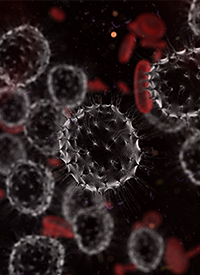Jaktinib Reduces Splenomegaly, Improves Symptom Burden in Ruxolitinib-intolerant Myelofibrosis
The novel JAK and AVCR1 inhibitor jaktinib demonstrated promising therapeutic activity in patients with myelofibrosis who were intolerant to or progressed on ruxolitinib.
Jaktinib Reduces Splenomegaly in Myelofibrosis | Image Credit: ©immimagery - stock.adobe.com

The novel JAK and AVCR1 inhibitor jaktinib demonstrated promising therapeutic activity in patients with myelofibrosis who were intolerant to or progressed on ruxolitinib (Jakafi), according to data from a phase 2b trial (NCT04217993) presented at the 2023 ASCO Annual Meeting.
Among patients treated with jaktinib at 100 mg twice daily who were evaluable for efficacy (n = 44), 43.2% experienced a spleen volume reduction of at least 35% (SVR35) from baseline at week 24, and SVR35 rates were generally consistent among patient subgroups. Notably, the best SVR35 rate at any time during the study was 54.5%, and the median time to first SVR35 was 12 weeks.
Moreover, responses were maintained in 80.4% of patients for a minimum of 24 weeks, and the median duration of response was not reached.
“Jaktinib given at 100 mg twice daily, orally, not only substantially reduced splenomegaly, but also ameliorated myelofibrosis-related symptom burdens and anemia. Jaktinib could be a new treatment for patients with anemia after ruxolitinib,” lead study author, Yi Zhang, MD, of Zhejiang University School of Medicine in Hangzhou, China, and colleagues, wrote in a poster presentation of the data.
The study enrolled patients between 18 and 75 years of age with primary myelofibrosis, post–polycythemia vera myelofibrosis, or post–essential thrombocythemia myelofibrosis. Previous treatment with ruxolitinib was required for at least 28 days, and patients needed to require either red blood cell (RBC) transfusions, more frequent transfusions on ruxolitinib, or have grade 3/4 anemia, thrombocytopenia, or hematoma while receiving ruxolitinib. Other key inclusion criteria included an ECOG performance status of 0, 1, or 2, a palpable spleen of at least 5 cm below the left costal margin, a platelet count of at least 100 x 1009/L, and a hemoglobin level below the lower limit of normal.
The phase 2b trial was split into 2 parts: dose finding (n = 7) and dose expansion (n = 44). The dose-finding portion evaluated jaktinib at 100 mg daily (n = 1), 150 mg daily (n = 4), 200 mg daily (n = 1), and 100 mg twice daily (n = 1) in 6-week cycles for at least 4 cycles. The dose-expansion portion evaluated jaktinib at 100 mg twice daily in 6-week cycles for at least 4 cycles.
The primary end point was SVR35 at week 24, which was assessed centrally by MRI and CT imaging. Key secondary end points included best SVR35 at any time during treatment, the proportion of patients with at least a 50% reduction in Myeloproliferative Neoplasm Symptom Assessment total symptom score (MPN-SAF TSS), anemia response, and safety.
At the data cutoff of April 22, 2022, treatment was ongoing in 68.9% (n = 31) of patients receiving jaktinib at 100 mg twice daily. Although 45 patients were treated with jaktinib at 100 mg twice daily, only 44 patients were evaluated in the full analysis for efficacy due to a false myelofibrosis diagnosis in 1 patient. This patient was included in the safety analysis.
In the 44 patients treated with 100 mg of jaktinib twice daily, the median age was 61.0 years (range, 29-75), and half of patients were male. Notably, 31.8% of patients had an ECOG performance status of 0, 54.5% had a performance status of 1, and 13.6% of patients had a performance status of 2. Furthermore, 81.8% of patients presented with primary myelofibrosis, 6.8% of patients had post–polycythemia vera myelofibrosis, and 11.4% had post–essential thrombocythemia myelofibrosis. The median time from diagnosis was 24.5 months (range, 2.7-169.6). Grading included myelofibrosis 1 (2.3%), 2 (34.1%), and 3 (63.6%).
Using the Dynamic International Prognostic Scoring System, 15.9%, 79.5%, and 4.5% of patients had intermediate-1–, intermediate-2–, and high-risk disease, respectively. The median spleen volume upon central review was 1,213.5 cm3 (range, 437.37-2984.15) and the median MPN-SAF TSS was 9.5 (range, 0-49). Additionally, 63.6% of patients were JAK2 V617F positive, and the median duration of previous treatment with ruxolitinib was 10.7 months (range, 1.5-90.5).
Regarding intolerance to ruxolitinib,, 42.7% of patients required RBC. Additionally, 90.9% of patients had grade 3 or higher anemia, 4.5% of patients reported grade 3 or higher thrombocytopenia, and 4.5% of patients had both grade 3 or higher anemia and thrombocytopenia.
Additional data showed that 41.9% of transfusion-independent patients with hemoglobin of 100 g/L or less at baseline experienced a hemoglobin increase of least 20 g/L. Additionally, among the 19 patients who required RBC transfusions at baseline, 57.9%of patients achieved a 50% decrease in RBC infusion frequency, and 47.4% had a 50% decrease in RBC infusion unit, respectively. One of 9 transfusion-dependent patients at baseline became transfusion independent.
At week 24, 61.8% of patients achieved at least a 50% improvement in TSS.
The median exposure to jaktinib was 280 days (range, 172-386), and 97.8% of patients experienced any-grade treatment-emergent adverse effects (TEAEs). Sixty percent of patients experienced grade 3 or higher TEAEs, and 35.6% of patients had serious TEAEs. Additionally, 11.1% of patients discontinued treatment due to TEAEs, and 26.7% needed dose interruptions or reductions due to TEAEs.
The most common hematologic TEAEs that occurred in 20% or more of patients included thrombocytopenia (any-grade, 44.4%; grade 3 or higher, 22.2%), anemia (37.8%; 31.1%), neutropenia (26.7%; 15.6%), and leukopenia (22.2%; 15.6%). The most common non-hematologic TEAEs that occurred in 20% or more of patients consisted of decreased weight (28.9%; 0%), pneumonia (22.2%; 17.8%), blood creatinine increase (22.2%; 0%), and blood bilirubin increase (22.2%; 0%).
Reference
Zhang Y Zhou H, Zio ZJ, et al. Jaktinib in patients (pts) with myelofibrosis (MF) who were intolerant to ruxolitinib (RUX): An open-label, single-arm phase 2b study. J Clin Oncol. 2023;41(suppl 16):7061. doi:10.1200/JCO.2023.41.16_suppl.7061




